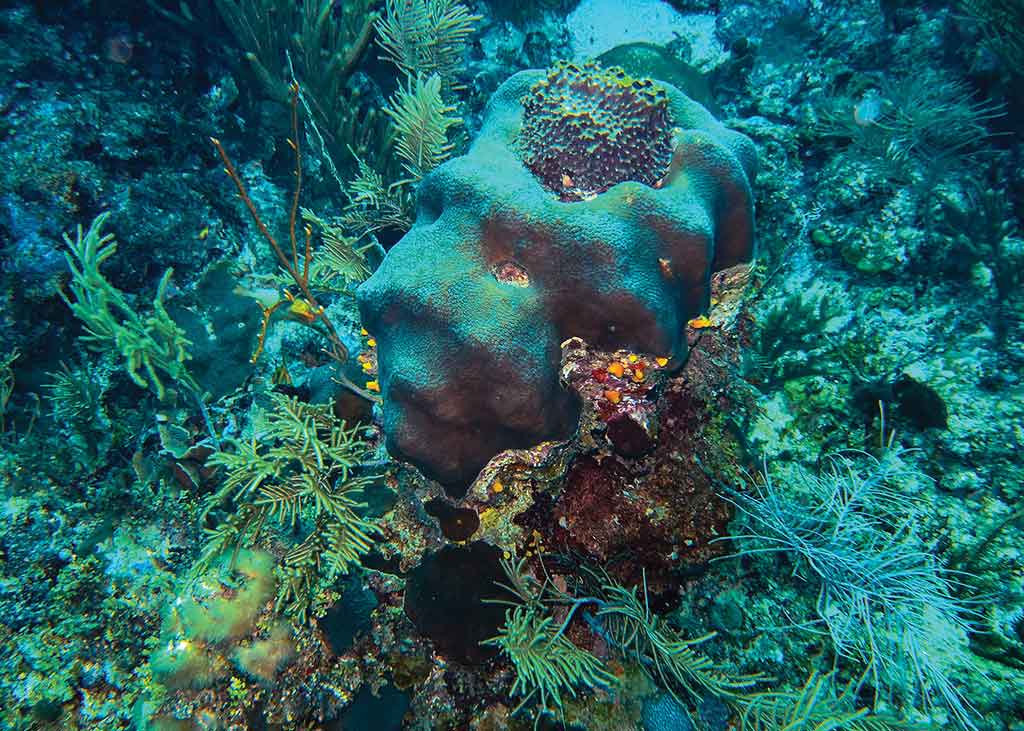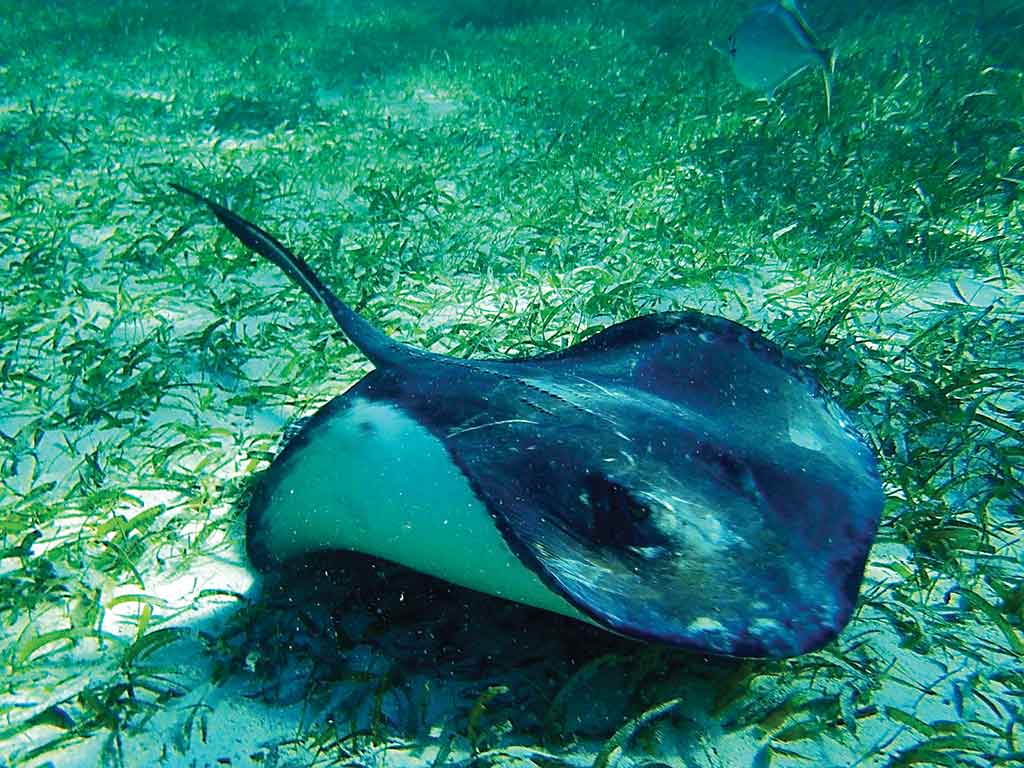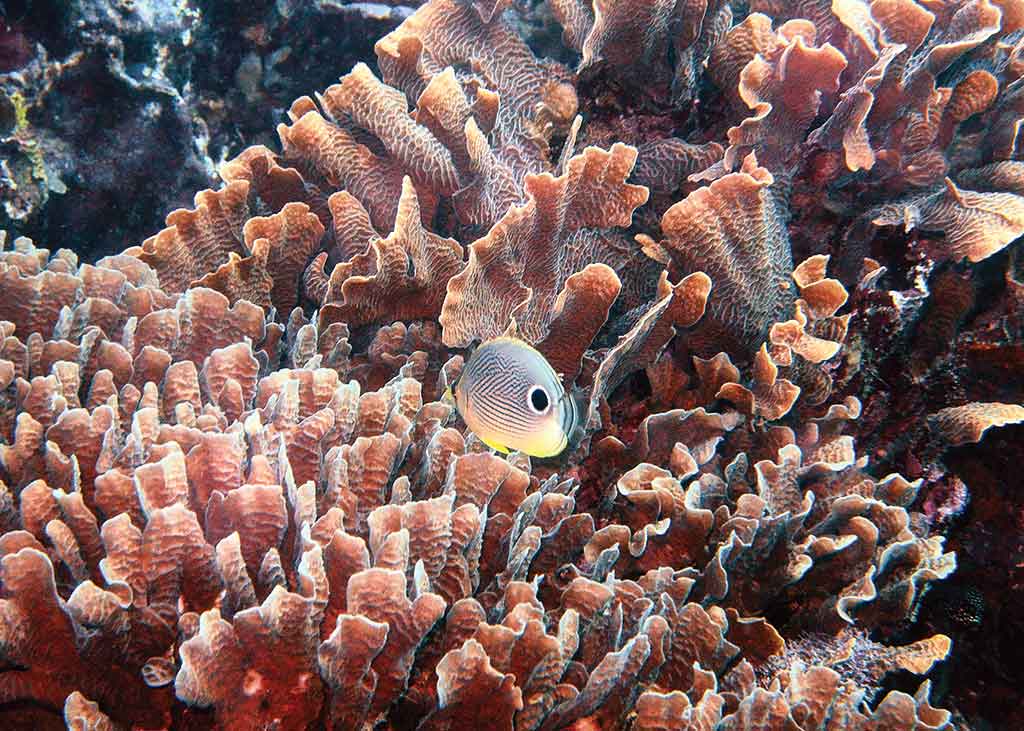Stretching 180 miles along Belize’s coast, from Bacalar Chico in the north all the way south to the Sapodilla Cayes, the Belize Barrier Reef continues to be a diving and snorkeling paradise. It’s also the most abundant section of the Mesoamerican Reef System, which extends from Mexico to Honduras and has been described by National Geographic as “half the length of its famous Australian counterpart but in many ways more remarkable.”
Snorkelers can spot rays, turtles, and other fish directly off a caye’s shores and in marine reserves.It’s not surprising then, that Belize’s waters are teeming with a rich underwater life. Approximately 70 hard coral species, 36 soft coral species, over 300 species of fish, and hundreds of invertebrates call these waters home. Nine protected marine reserves and an intricate system of various habitats allow these hundreds of creatures to thrive.
Belize’s waters are teeming with unique coral formations. Photo © Lebawit Lily Girma.
Divers will find guaranteed bliss off the magnificent coral atolls, while snorkelers can spot rays, turtles, and other fish directly off a caye’s shores and in marine reserves. Whether you’re a beginner or certified underwater aficionado, Belize’s splendid down under is sure to impress. Here are a few of the Caribbean critters you’ll encounter, with plenty of others to be found in Moon Belize Cayes–sea turtles, dolphins, spiny lobsters, corals and so much more. The good news is, you don’t have to be a diver to see them all!
These “gentle giants of the sea” can reach between 600 and 1,200 pounds, and move ever so gracefully across the waters, rising to the surface in intervals to breathe. Belize is considered the last stronghold for the endangered West Indian manatee. In 2012, aerial surveys of Turneffe Atoll and Belize’s coastline revealed 507 manatees. It’s estimated that the global population of this species is less than 2,500.
While swimming with manatees is prohibited, you can hop on manatee-watching tours. You’re likely to see them on a trip along Swallow Caye Wildlife Sanctuary or off Caye Caulker Marine Reserve, particularly during the summer. Manatees also inhabit Placencia Lagoon, and you may come across one during a boat ride off the Placencia coast and on the way to southern cayes.
Swimming alongside rays can be a little intimidating at first, but these are harmless creatures, as long as you leave them undisturbed. They are in abundance in Belize, home to the southern stingray, the manta ray, and the spotted eagle ray.
The southern stingray can reach up to five feet across, with a long and thin tail outfitted with venomous barbs 4-8 inches long. The elusive spotted eagle rays are mesmerizing; their glorious wing-like appendages allow them to move quickly and give them the appearance of flying through the sea. Their numerous white spots dramatically contrast with the sea wall’s clear and deep blues. The spotted eagle ray has a longer tail equipped with up to five barbed spines. Its wingspan can reach up to five feet. They are considered threatened and are often hunted by sharks.
Manta rays have a wingspan reaching up to 20 feet and are often seen leaping in and out of the water up to 10 feet high.
Tip: When entering the water from the beach, particularly off the cayes, be sure to do the “stingray shuffle”—slowly rub the sandy bottom as you enter, in order not to startle any rays that may be resting on the sea floor, where they usually sit when not swimming.
Get a close glimpse of southern stingrays on a trip to Hol Chan Marine Reserve, ideal for beginner and advanced snorkelers. Caye Caulker Marine Reserve also has its very own stingray alley, where you’ll be surrounded by southern stingrays—a thrill for both adults and young ones. You’ll spot them rushing towards the boat as it arrives, as they’re used to the daily visits and feedings. In the south, southern stingrays and spotted eagle rays are a likely sight at Gladden Spit, Parrot Reef off South Water Caye, and the North Wall off the Silk Cayes. Manta rays can be seen from Ambergris and Caye Caulker all the way to the Sapodilla Cayes, where they even come right up to shore along Lime Caye.

A stingray at Caye Caulker Marine Reserve. Photo © Lebawit Lily Girma.
Species of sharks present along Belize’s coastline include docile nurse sharks, Caribbean reef sharks, bull sharks, black tip sharks, lemon sharks, hammerheads, scalloped hammerheads (though rare), and the impressive, migratory whale sharks. Hard as it may be at first, put aside the myth that all sharks are out to immediately attack humans. You will end up surprised when a Caribbean reef shark passes by and ignores your presence. Thanks to a complex and diverse reef system, it’s not unusual to spot sharks on a dive, particularly off one of the coral atolls. The most common species are nurse sharks, reef sharks, and, in season, whale sharks.
Nurse sharks are bottom dwellers that pose no threat and are used to divers for the most part—but don’t touch them! They feed on crustaceans, mollusks, and other fish, and can grow up to 14 feet and weigh over 700 pounds. Nurse sharks are in abundance in Belize and are easiest to spot in marine reserves.
Aside from nurse sharks, reef sharks are the most commonly encountered in Belize. They can reach up to 10 feet in length, have long and narrow fins, and have an impressive aura about them, reminding you of those Hollywood-type sharks. But not to worry—they feed primarily on reef fish and are generally harmless to humans. They can get aggressive where there is bait, however, so beware if you’re out spearfishing.
Whale sharks are a primary attraction in Belize for visitors who wish to snorkel or dive with these giant creatures. They are the largest fish in the sea (up to 66 feet in length and weighing over 15 tons).
You are guaranteed to see nurse sharks at Hol Chan Marine Reserve’s Shark Ray Alley. The thrill is to jump from the boat into waters with 20-30 of them. You can visit a similar shark ray alley at Caye Caulker Marine Reserve.
Divers will occasionally spot Caribbean reef sharks or the great hammerhead on trips to the atolls, particularly Lighthouse Reef, home to the infamous Blue Hole.
Whale sharks can be viewed at Gladden Spit during the whale shark season from April to May, three or four days before and after a full moon.
Great barracuda are common residents of Belize’s waters. Capable of speeds up to 22 miles per hour, these predators have a “bad boy” rep and are intimidating to divers with their sleek, silver bodies (up to five feet long), mean stare, and razor-sharp, fang-like teeth. But they don’t go after humans; they’re just as curious as you are. They may shadow you but there’s no need to panic. Avoid touching or feeding them and maintain your distance. Beware that they’ve been known to attack people wearing bright jewelry and watches—likely a starving barracuda mistaking anything shiny for bait.
Great barracuda can be seen on almost any dive or fishing excursion all along the Belize Barrier Reef and cayes, goinzg north to south. They are particularly abundant and easy to spot on snorkel trips to Laughingbird Caye National Park and the Snake Cayes Marine Reserve.
Angelfish are the beauties of Belize’s reef. These shy creatures with large spines and rounded heads come in bright and attractive hues, gracefully roaming the waters as they feed on sponges and algae. Of about 80 species in the tropical world, at least four are found in good numbers in Belize: the queen angelfish (the most striking, with an electric blue body and a yellow tail), the French angelfish, the blue angelfish, and the gray angelfish. They love to stick close to coral or rock reefs, which makes for vibrant photographs. The four-eyed butterflyfish and the spotfin butterflyfish (with a black line running through its eye) are frequent in Belize.

Four-eyed butterfly fish along the Belize Barrier Reef. Photo © Lebawit Lily Girma.
You’ll spot angelfish and the four-eyed butterflyfish on literally any dive trip to the reef, including snorkeling at Mexico Rocks off Ambergris Caye. They are particularly abundant off the southern and deep southern cayes and the atolls.
Excerpted from the First Edition of Moon Belize Cayes.